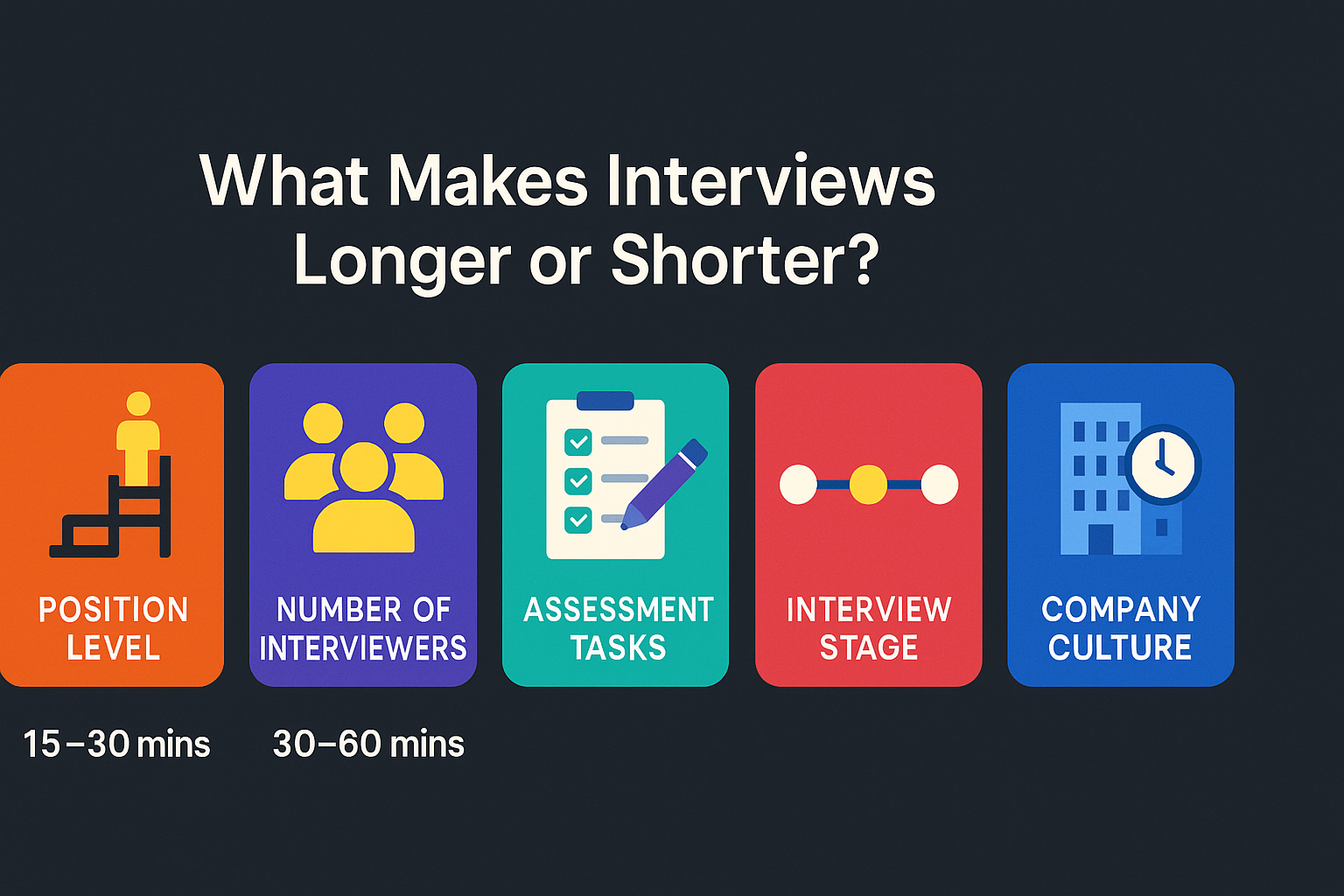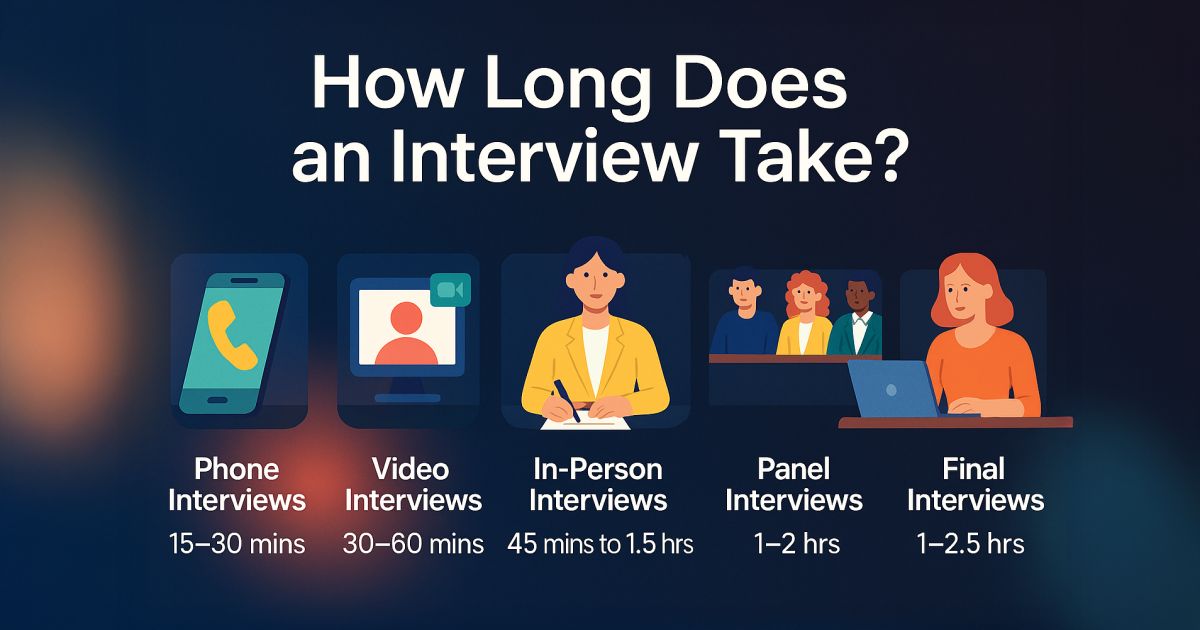Introduction
How long an interview should be or expected to be? There is no fixed time actually. The answer changes from one case to another. Sometimes the meeting is short. Sometimes it takes much longer than expected.
So, if you know what to expect, then you can prepare better. This is the reason it helps to understand the usual length.
Say you have a short phone call with a recruiter. It may end in 10 minutes. Maybe even less. But if it is a final round with a senior manager, then it may go over one hour.
Read why does the interview time varies.
Typical Duration of Different Interview Types
Every interview type has a reason. So, time is not the same for all. Some take less, some take more.
Large companies like Google, Amazon, Meta, and Microsoft also follow these steps. But they usually add more structure. Sometimes they add more people. Sometimes more questions.
This is why knowing the type can help.
Phone Interviews
- Average time: 15 to 30 minutes
It’s your first round. Then it’s likely short. Often the goal is to check your resume, your voice, and if you fit the job. They ask only a few basic things. If you apply at Google. Then a recruiter calls first. They ask basic questions. Maybe about your work. Maybe about your resume. Amazon also starts this way. But they often check if you match their work values. This is how they decide if you should move forward. Sometimes it ends fast. Maybe 15 minutes. Maybe 30. It depends on the job.
Video Interviews
- Average time: 30 to 60 minutes
This one work when travel is not easy or you and the company are not in the same place. So, video helps. It may feel like a face-to-face talk. They may ask about your behaviour in past jobs. Tech giant companies like Meta and Netflix use video often. You answer on camera. You talk like face-to-face. They may ask how you solved problems in past jobs. They may ask what you do in pressure. Microsoft, for example, may ask how you worked with others. Or how you managed time.
In-Person Interviews
- Average time: 45 to 90 minutes
For example, if you visit the office, it often takes longer. Maybe they ask you to meet a few people. Maybe they show you around. So, they try to learn about you in detail. Your past jobs, your skills, your work habits. This round is longer. Apple may use this to test how well you match their team. They ask deeper questions. They look at your work style. They may show you the place. Maybe you meet a manager. Maybe someone from your future team.
Panel Interviews
- Average time: 1 to 2 hours
More people, more time. If 3 or 4 people ask you questions, the interview grows longer. This is how they hear from different teams. So that each one can decide if you are a good choice. Sometimes, they take turns. Maybe one checks coding. Maybe one asks about teamwork. IBM and Intel use this often. LinkedIn also uses this model.
Final Interviews
- Average time: 1 to 2.5 hours
This step is last. It is detailed. It takes more time. You may meet a senior person. Maybe a director. Maybe someone from top-level. Amazon, in this round, checks your choices. They ask what you would do. They want to see how you lead. Google may call you for more than one talk. They may split it into parts. You may talk to many teams. They may talk about money. They may give one last task. So they can see how you work.
This is why this stage takes more time. If you reach this far, then they already like your profile. But they want to be very sure.
Factors Affecting Interview Length
Not all interviews take the same time. Some finish fast. Others go longer than planned. This is how several things can affect how long the interview takes. Big tech companies also follow similar patterns. But they often add more layers. Sometimes more people. Sometimes more questions.
- Position Level: The job is senior. Then it's likely to take more time. They want to check more skills. So that they feel sure before they choose. This is the reason top-level roles often need longer talks. Google, for example, gives more interview rounds for staff engineer or product manager positions. The questions go deeper. They check leadership, system design, and decision-making. Amazon takes more time for roles above level 5. Candidates meet more team members. They must also show how they follow the company’s Leadership Principles. This is the reason higher-level jobs include longer talks.
- Number of Interviewers: Maybe only one person talks to you. Then it stays short. But if three or four people join, it grows. More people ask more things. So you spend more time answering. If you apply at Microsoft. You may speak to a hiring manager. Then a peer. Then someone from HR. Each one asks from a different view. LinkedIn often uses panels. So they ask in turns. Or they ask together. You give more answers. You hear more questions. So you spend more time. This is how group interviews often become long.
- Assessment Tasks: Sometimes you must solve a task. Maybe it’s a test. Maybe a case study. If yes, then the interview can go beyond the usual time. Meta (Facebook) often includes take-home assignments or coding problems for engineering roles. Apple, for some design or strategy jobs, gives tasks that show how you think. This adds extra time. Sometimes before the main interview. Sometimes during. So the interview grows beyond a usual chat.
- Interview Stage: The first talk is mostly short. Just a basic check. But if you reach the last round, the time increases. They explore your fit in depth. This is how the stage matters. But if you reach the last round, the talk gets longer. So that they know more about how you solve problems. Amazon’s final loop has 4–6 rounds in one day. Google may divide the final into back-to-back sessions. Each one focused on a new skill. This is how later rounds take more time. Because the goal is different. It is not just to check. It is to decide.
- Company Culture: Some companies fix the time. Such as 45 minutes or 60. They follow a plan. Google usually keeps interviews between 45 to 60 minutes each. Even if you talk to many people. But others, like Netflix, may keep it open. Maybe they finish fast. Maybe they go longer. If they like you, they may ask more. This is how company culture changes the timing. Some want structure. Some want flexibility. So, the time often depends on what the company values.

Strategies for Managing Interview Duration
You cannot always guess how long the interview will take. So, it helps to follow a few steps to stay ready. Here are some strategies for maintaining interview duration:
- Clarify Upfront: If, you get the invite. Then ask how much time you should keep. This is how you plan your day. Maybe they tell you 30 minutes. Maybe more.
- Prepare Thoroughly: By this way, you use time better. Practice short answers. But keep them clear. If you explain well, they may not need to ask again.
- Stay Flexible: Sometimes it runs late. Maybe they have more questions. So keep some extra time in your schedule. This is the reason you should not fix anything just after the interview.
- Pace Yourself: Speak clearly. Not too fast. Not too slow. If you rush, you miss details. But if you talk too long, they may lose interest. So that you keep a good flow, find a middle point.
Common Misconceptions About Interview Length
People often think time tells the result. But this is not always true.
- "Short Means I Failed"
The interview ends in 15 minutes. You may feel bad. But that does not always mean something went wrong. Maybe the recruiter saw what they needed. Maybe your answers were clear. Maybe you fit the job from the start. So they did not need more time. For example, Google sometimes makes quick hiring decisions after short recruiter screens. If you answer well, they may not stretch the call. Amazon also checks for basic alignment with their values in the first call. If you match their Leadership Principles, they may move you to the next round without delay. This is the reason a short talk is not always a sign of failure. Sometimes it is a fast “yes.” - "Long Interviews Mean I Got the Job"
If your meeting lasted 90 minutes. Maybe you think that means you passed. But long time does not always mean success. Some companies have set formats. Each round is fixed at 45–60 minutes. They follow the rule, no matter what. Meta (Facebook), for example, schedules each round to test a specific skill. One for problem-solving. One for communication. One for behaviour. So if you talk longer, it may just mean more people needed input. Not that the answer is yes. This is how a long talk can still end without a job offer. - "One Interview Is Enough"
Many people expect a single round. But most companies don’t hire this way. They want to be sure. Microsoft, Apple, and Amazon usually run multiple stages. A first screen. Then a technical round. Then maybe a final loop or panel. If you move forward, then you may speak to three or four people. Sometimes on the same day. Sometimes in parts. This is why one round is not always the end. It is only the start. So, if you finish one round, do not stop preparing. You may still have more to face.
Preparing for Different Interview Lengths
Not all interviews need the same level of detail. So, if you know the time, then you can plan better. This is how you save effort and stay ready.
- 15–30 Minutes:
Keep it simple. Talk about your resume. Share the most useful points. Focus on why you match the job. Say just what matters. - 30–60 Minutes:
Prepare more. Use examples from your past. Follow the STAR method if you can. So that your answers stay clear. Maybe ask a few smart questions too. - 60+ Minutes:
If it’s a long talk. Then go deep. Be ready to explain full projects. Talk about your role. What went well. What went wrong. Show what you learned. This is the reason they spend more time. They want to know your full value.
Maybe interview short or long. But you stay in control either way.

Conclusion
Knowing the time range helps. You feel less stress. So, you focus better. If you have a short call. Then you keep your points clear. If it’s long, then you go deeper. By this way, you stay ready for any format. Understand the role. Ask about the time. Plan before the talk. This is how you prepare well. Maybe it runs longer than planned. Maybe not. But you manage better when you expect both. This is the reason time awareness matters in interviews.
Ace your interview with Synco AI
Synco AI enhances your interview performance through personalized coaching and real-time support:
It helps you get ready with steps that fit your needs.
- Preparation - Say you have notes and ideas. Synco AI helps you keep them in one place.
- Confidence - It shows what to say if a question feels new.
- Accuracy - You get feedback fast.
- Integration - It hears your answers and writes them down. No noise. No pause.
- Personalization - The help fits your past work and skills.
- Feedback - You see what worked and what did not.
Boost your interview success effortlessly with Synco AI.



